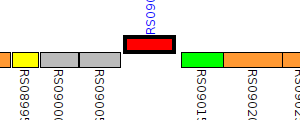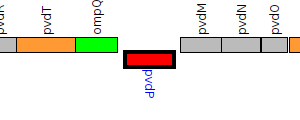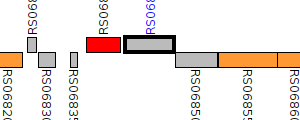In order to generate a more inclusive dataset of Pseudomonas genes mapped to putative in-paralogs and putative orthologs in other Pseudomonas species/strains, we developed a Pseudomonas Orthologous Groups classification system.
To generate ortholog groups, pair-wise DIAMOND searches were run on all genomes in the database to find reciprocal best hits (RBHs) for each gene. These analyses often resulted in multiple candidate genes for RBH status, which were narrowed down by examining the similarity between the query's flanking genes and the hit's flanking genes. If two candidate genes were directly adjacent, they where both accepted as RBHs that involve putative in-parology.
Pairwise intra-genome DIAMOND searches were also performed to acquire in-paralog information (i.e. gene duplications occurring after species divergence). If two genes in one genome were reciprocally more similar to each other than to any gene in the other genomes, the two genes were designated putative in-paralogs. Ortholog groups are built by starting with a seed gene and then adding all genes to which there is a RBH or in-paralog relationship.
Every new gene added to an ortholog group was then treated as a seed gene and the addition process was repeated until all qualifying genes had been added. The result was the development of orthologous groups, specifically generated for Pseudomonas species genomes, which can be used to sort search results.
Pseudomonas Ortholog Group POG003135
| Strain | Locus Tag | Description | Same-Strain Members | Fragment ? | |
|---|---|---|---|---|---|
| Pseudomonas sp. WCS358 | PC358_RS10225 |
PvdJ/PvdD/PvdP-like protein
|
1 member |

|
|
| Pseudomonas sp. WCS374 | PD374_RS11960 |
PvdJ/PvdD/PvdP-like protein
|
1 member |

|
|
| Pseudomonas synxantha BG33R - Assembly GCF_000263715.2 | PseBG33_2452 |
chromophore maturation protein PvdP
pvdP |
1 member |

|
|
| Pseudomonas syringae B576 | NG81_RS11820 |
PvdJ/PvdD/PvdP-like protein
|
1 member |

|
|
| Pseudomonas syringae BRIP39023 | A988_11414 |
twin-arginine translocation pathway signal
|
1 member |

|
|
| Pseudomonas syringae CC1557 | N018_RS09010 |
PvdJ/PvdD/PvdP-like protein
|
1 member |

|
|
| Pseudomonas syringae DSM 10604 | PSSR_RS0116705 |
PvdJ/PvdD/PvdP-like protein
|
1 member |

|
|
| Pseudomonas syringae pv. actinidiae ICMP 9617 | A250_RS10270 |
chromophore maturation protein PvdP
|
1 member |

|
|
| Pseudomonas syringae pv. coryli NCPPB 4273 | P406_RS13640 |
PvdJ/PvdD/PvdP-like protein
|
1 member |

|
|
| Pseudomonas syringae pv. syringae 41a | PSS41A_RS01515 |
PvdJ/PvdD/PvdP-like protein
|
1 member |

|
|
| Pseudomonas syringae pv. syringae B301D | PSYRB_RS09570 |
PvdJ/PvdD/PvdP-like protein
|
1 member |

|
|
| Pseudomonas syringae pv. syringae B301D-R | PSSB301D_RS20570 |
PvdJ/PvdD/PvdP-like protein
|
1 member |

|
|
| Pseudomonas syringae pv. syringae B64 | PssB64_3875 |
twin-arginine translocation pathway signal
pvdP |
1 member |

|
|
| Pseudomonas syringae pv. syringae B728a (Feil et al., 2005) | Psyr_1967 |
twin-arginine translocation pathway signal
|
1 member |

|
|
| Pseudomonas syringae pv. syringae HS191 - Assembly GCF_000988395.1 | PSYRH_RS16330 |
PvdJ/PvdD/PvdP-like protein
|
1 member |

|
|
| Pseudomonas syringae pv. syringae SM | PssSM_2032 |
Pyoverdine biosynthesis-related protein PvdP
pvdP |
1 member |

|
|
| Pseudomonas syringae pv. tomato NYS-T1 | NB04_RS10740 |
Tat (twin-arginine translocation) pathway signal sequence domain protein
|
1 member |

|
|
| Pseudomonas syringae UB0390 | IV03_RS12710 |
PvdJ/PvdD/PvdP-like protein
|
1 member |

|
|
| Pseudomonas taetrolens DSM 21104 | TU78_RS06845 |
PvdJ/PvdD/PvdP-like protein
|
1 member |

|
|
| Pseudomonas taiwanensis DSM 21245 | H620_RS0124600 |
PvdJ/PvdD/PvdP-like protein
|
1 member |

|